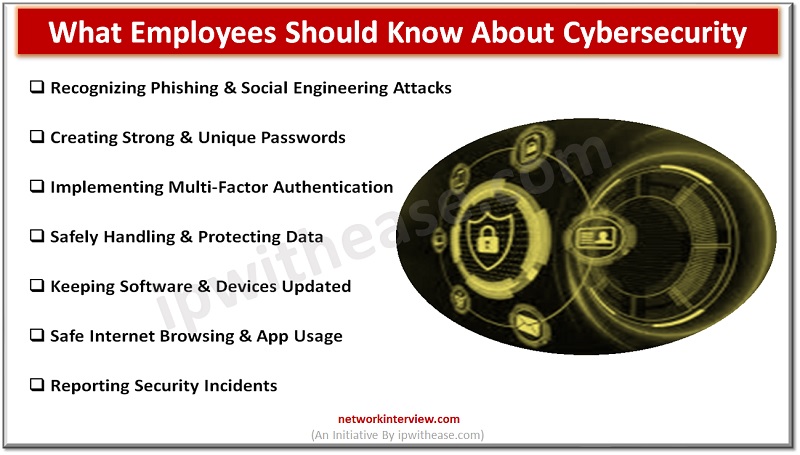
Top Things Your Employees Should Know About Cybersecurity
In today’s digital age, cybersecurity is a critical concern for businesses of all sizes. With cyber threats becoming more sophisticated and prevalent, it is essential for employees to be well informed and proactive in protecting sensitive company and customer data.
This comprehensive guide aims to highlight the top things your employees should know about cybersecurity. By understanding the risks, adopting best practices, and remaining vigilant, employees can become valuable assets in safeguarding your business from cyber threats.
The Importance of Cybersecurity Awareness
The importance of cybersecurity awareness cannot be overstated in today’s digital landscape. Employees need to recognize that they play a crucial role in maintaining a secure work environment and protecting the organization from cyber threats. By understanding the potential risks and the consequences of a breach, employees become more motivated to prioritize cybersecurity measures and actively engage in efforts to safeguard sensitive information.
Cyber attacks can have severe repercussions for businesses, ranging from financial losses due to stolen funds or disrupted operations to irreparable damage to the company’s reputation. Data breaches can expose sensitive customer information, leading to loss of trust and potential legal liabilities. By understanding the gravity of these potential outcomes, employees are more likely to be proactive in implementing and adhering to cybersecurity protocols.
Recognizing Phishing & Social Engineering Attacks
Recognizing phishing and social engineering attacks is crucial for maintaining cybersecurity within an organization. These types of attacks aim to deceive employees into revealing sensitive information or taking actions that can compromise data security. Educating employees about these tactics and providing them with the necessary knowledge to identify and respond to such attacks is essential for safeguarding the organization’s digital assets.
Phishing attacks often occur through emails, messages, or phone calls that appear to be from legitimate sources but are actually fraudulent. Employees should be trained to look for common signs of phishing, such as misspellings, grammatical errors, suspicious email addresses or URLs, and requests for personal or sensitive information. They should be cautious when opening attachments or clicking on links in unsolicited messages, especially if they are unexpected or create a sense of urgency.
Social engineering attacks, on the other hand, involve manipulating individuals through psychological tactics to gain access to confidential information. This can include impersonating a trusted colleague or using social media to gather personal information for targeted attacks.
Creating Strong & Unique Passwords
The importance of cybersecurity awareness cannot be overstated in today’s digital landscape. Employees need to recognize that they play a crucial role in maintaining a secure work environment and protecting the organization from cyber threats. By understanding the potential risks and the consequences of a breach, employees become more motivated to prioritize cyber security awareness and measures and actively engage in efforts to safeguard sensitive information. Cyber attacks can have severe repercussions for businesses, ranging from financial losses due to stolen funds or disrupted operations to irreparable damage to the company’s reputation.
Data breaches can expose sensitive customer information, leading to loss of trust and potential legal liabilities. By understanding the gravity of these potential outcomes, employees are more likely to be proactive in implementing and adhering to cybersecurity protocols.
Implementing Multi-Factor Authentication (MFA)
Implementing Multi-Factor Authentication (MFA) is a crucial step in enhancing cybersecurity within your organization. By requiring employees to provide additional verification beyond their password, such as a unique code sent to their mobile device, MFA adds an extra layer of protection against unauthorized access.
Encouraging employees to enable MFA for their work-related accounts is highly recommended, as it significantly reduces the risk of breaches even if passwords are compromised. With MFA in place, cybercriminals would need more than just stolen credentials to gain access, providing an additional barrier against unauthorized entry into your systems and sensitive data.

Safely Handling and Protecting Data
Safely handling and protecting data is of utmost importance in maintaining cybersecurity within an organization. Employees play a vital role in ensuring the confidentiality, integrity, and availability of sensitive information. It is crucial to educate employees on the proper handling and protection of data, empowering them to be responsible custodians of valuable company assets.
First and foremost, employees should be educated about data classification and the importance of treating data based on its sensitivity. This includes identifying and understanding the different levels of data classification, such as public, internal, confidential, or restricted. Employees should be aware of their responsibilities when working with each type of data and follow the established protocols for handling and accessing information according to its classification.
Keeping Software and Devices Updated
To encourage employees to prioritize software and device updates, businesses should provide clear guidelines and raise awareness about the importance of these updates. Regular reminders, training sessions, and automated update notifications can help ensure that employees stay informed and take necessary actions to keep their software and devices up to date.
Software updates typically include security patches that address known vulnerabilities, bug fixes, and enhancements. By promptly applying these updates, employees can close security gaps and protect their devices and data from potential cyber attacks. Organizations should emphasize that these updates should not be neglected or postponed, as they play a critical role in maintaining the integrity and security of the entire network infrastructure.

Safe Internet Browsing and App Usage
Employees should understand the risks associated with visiting untrusted websites or downloading apps from unverified sources. Encourage safe internet browsing practices, such as avoiding suspicious websites and refraining from clicking on pop-up ads or downloading unauthorized software. Employees should also be cautious about granting unnecessary permissions to mobile apps and only downloading applications from reputable sources.
Reporting Security Incidents
Reporting security incidents is a critical component of maintaining effective cybersecurity within an organization. Employees should understand the significance of promptly reporting any suspected security incidents or potential breaches to the designated IT or security team. By fostering a culture of transparency and open communication, businesses can empower their employees to take immediate action, thereby minimizing the impact of security incidents and enabling timely response and remediation.
Employees should be educated on what constitutes a security incident, such as unusual system behavior, unauthorized access attempts, or suspicious emails or attachments. They should also understand the potential consequences of not reporting such incidents, including prolonged system vulnerabilities, data breaches, and compromised sensitive information.
Cybersecurity is a shared responsibility within any organization, and employees play a crucial role in maintaining a secure business environment. By understanding the risks, following best practices, and remaining vigilant, employees can contribute to the overall cybersecurity posture of the company. Regular training, clear policies, and ongoing communication are essential to ensure that employees are equipped with the knowledge and skills necessary to protect sensitive data and thwart cyber threats.
With a well-informed and security-conscious workforce, businesses can mitigate risks, safeguard their reputation, and ensure the confidentiality and integrity of their digital assets.
Continue Reading:
Phishing vs Spam: Cyber Attack Techniques
Spear Phishing vs Whaling: Cyber Attacks



